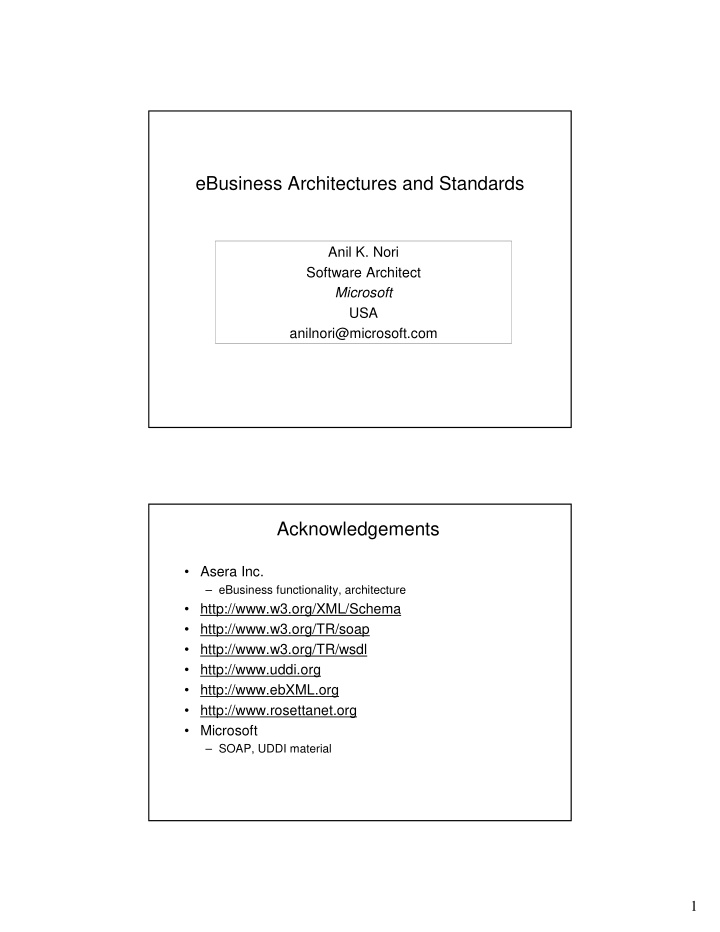



eBusiness Architectures and Standards Anil K. Nori Software Architect Microsoft USA anilnori@microsoft.com Acknowledgements • Asera Inc. – eBusiness functionality, architecture • http://www.w3.org/XML/Schema • http://www.w3.org/TR/soap • http://www.w3.org/TR/wsdl • http://www.uddi.org • http://www.ebXML.org • http://www.rosettanet.org • Microsoft – SOAP, UDDI material 1
Agenda • Evolution of eBusiness • eBusiness Applications • eBusiness Architecture • eBusiness Standards • Discussion Fundamental eBusiness Problems • eBusiness is all about automating business processes of an enterprise. – Within the enterprise: across divisions, employees – Across the enterprise: suppliers, partners, customers • Most eBusiness interactions are complex, labor and information intensive – complex, collaborative manual processes – timely and accurate information exchange is a challenge • Commerce is fragmented by geography – creates inefficient markets, uninformed buyers and sellers • Supply chains are bloated with excess inventory – inability to see and plan right products and quantities 2
Demand for Market Visibility • Price Visibility • Availability Visibility • Supplier Visibility • Product Visibility Need for Collaboration • Within and across enterprise • Human and machine collaboration • Partner centric • Support exception and event-driven alerts • Support response management 3
Opportunities for Optimization • Analyze and optimize enterprise business processes • Synchronize plans and forecasts across multiple parties • Optimize integrations • Dynamic reconfiguration of processes Agile Enterprise • Enterprise business processes are complex and continue to evolve • Customization is critical • Personalization is essential – Any geography – Any device – Any person • Efficient manageability is important 4
eBusiness: Past • Using FAX, Paper and Telephone – inefficient, error-prone, expensive • EDI networks – standardized, reduced errors – batch oriented, expensive – proprietary VANs – point-to-point connections; lacks market Visibility – expensive; cut small suppliers out BUT, EDI still lives! eBusiness: First Generation • Basic Electronic Commerce (E-Commerce) – Internet based sales channel – No intermediary – Mostly brochure-ware – Catalogs, marketing collateral – Sales promotions 5
eBusiness: Next Generation • Collaborative and communities of Commerce – Create market Visibility – Collaboration across geographies – Reflection of complex business workflow between demand and supply chains – Complex and dynamic trade, e.g. auctions and exchanges – Real-time supply chain management – Supports transactional and value added services Enterprise Business Processes Contract Planning and Sales Order Forecast Scheduling Purchase Manufacturing Order Shipping Finished Goods Accounts Accounts Receiving Inventory Sales History Payable Receivable 6
The Bigger Commerce Chain Picture Consumer C a r r i e r s Retailer Net Enabled e-Business Distributor Manufacturer � Goods & Services Supplier � Funds � Information Agenda • Evolution of eBusiness • eBusiness Applications • eBusiness Architecture • eBusiness Standards • Discussion 7
A Typical Commerce Process Is Not Simple ��������������� ����������� ������������� �������� ������� ���������������� �������������������� ��������� ��������� ������������ ����������� ������������� ���!������ �"������ ��������������� Resulting In A Chaotic Customer Experience….. Customer Records Not Synchronized Manual Tasks ��������������� ����������� To Complete ������������� �������� Orders ������� ���������������� �������������������� ��������� ��������� ������������ #������ #�!����� ����������� ������������� Disconnected Web Processes Not Channels ���!������ Integrated ��������������� through Order Fulfillment Manual Order Separate Tracking Process Orders for �"������ Multiple Locations 8
Streamlined Processes Real Time Business Intelligence Customer Order Status Customer Ordering Branded Portal And Order Management ��������������� ����������� ���������������� ���������������� ��������������� ������������� �������������������� Search Get Conform Check Check Get Purchase For Product Product Product Status Price Product Product Help Documents Availability Deliver ��������� ���!������ ��������� ����������� ������������ ������������� �"������ Aggregated Catalog Solutions Management Pricing and Contract For Application Information Customization, Configuration, Extension Typical Commerce Solutions Access Order Search & Design & Negotiate Place Change Fulfill Products Status Select Configure & Price Order Order Order & Info Visibility 9
Some fundamentals of Supply Chain How do you define Supply Chain Management? Organization of the overall business processes to enable the profitable transformation of raw materials or products into finished goods and their timely distribution to meet customer demand � What is the Goal of Supply Chain Management? Improving customer service through reliable and on-time delivery while reducing the cost of operations such as inventory, transportations cost, resource allocation and asset utilization. Major elements of the Supply Chain? Design – Plan – Buy – Make – Move (Store / Distribute) – Sell Supply Chain is Complex and Expansive MES MES Phone, Fax, eMail ERP ERP ERP Planning Planning Planning MES ���� ������������ ��������� ��������������� ������������ ��������� Inventory Mgmt ��������� Logistics Programs ����������� ������������� ��������������� Procurement MES ����������� ERP ERP ������������� Planning Enterprise $ ���������������� $ %������������&����� �������!���"�� ����'�����()��*��������� $ ������������������������ 10
Recommend
More recommend